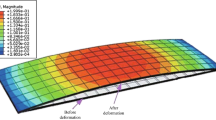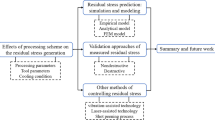Abstract
Residual stress in the machined surface can significantly influence the performance of machined parts. The influence of machining parameters and tool parameters on machining-induced residual stress has drawn much research interests, yet the distribution of initial stress is also an important factor that decides the final residual stress distribution, and there is a complicated evolution process of inner stress field during machining. In this paper, an experimental research was carefully designed and performed, with the help of FEM analysis, to study the evolution process of residual stress field during successive machining. Machining process can cause much more severe influence on the stress field than pure material removal process without external loads. The surface residual stress is mainly decided by the final machining process, while the in-depth residual stress distribution depends on the machining history. Machining process introduces non-uniform plastic deformation. When the Natural Plastic Influencing Range of certain cutting process is much smaller than the existing range of initial stress, this cutting process would either enlarge or reduce the amplitude of the stress distribution, depending on the nature of the initial stress field and the cutting loads, yet it would not significantly influence the existing range of the initial residual stress.
Similar content being viewed by others
References
Takakuwa O, Soyama H (2015) Effect of residual stress on the corrosion behavior of austenitic stainless steel. Adv Chem Engi Sci 05(01):62–71. https://doi.org/10.4236/aces.2015.51007
Thimmarayan R, Thanigaiyarasu G (2010) Effect of particle size, forging and ageing on the mechanical fatigue characteristics of Al6082/SiCp metal matrix composites. Int J Adv Manuf Technol 48(5-8):625–632. https://doi.org/10.1007/s00170-009-2316-0
Huang X, Sun J, Li J (2015) Finite element simulation and experimental investigation on the residual stress-related monolithic component deformation. Int J Adv Manuf Technol 77(5-8):1035–1041. https://doi.org/10.1007/s00170-014-6533-9
Masoudi S, Amini S, Saeidi E, Eslami-Chalander H (2015) Effect of machining-induced residual stress on the distortion of thin-walled parts. Int J Adv Manuf Technol 76(1-4):597–608. https://doi.org/10.1007/s00170-014-6281-x
Gang L (2009) Study on deformation of titanium thin-walled part in milling process. J Mater Process Technol 209(6):2788–2793. https://doi.org/10.1016/j.jmatprotec.2008.06.029
Nespor D, Denkena B, Grove T, Böß V (2015) Differences and similarities between the induced residual stresses after ball end milling and orthogonal cutting of Ti-6Al-4V. J Mater Process Technol 226:15–24. https://doi.org/10.1016/j.jmatprotec.2015.06.033
Hua J, Shivpuri R, Cheng X, Bedekar V, Matsumoto Y, Hashimoto F, Watkins TR (2005) Effect of feed rate, workpiece hardness and cutting edge on subsurface residual stress in the hard turning of bearing steel using chamfer + hone cutting edge geometry. Mater Sci Eng A 394(1-2):238–248. https://doi.org/10.1016/j.msea.2004.11.011
Hua J, Umbrello D, Shivpuri R (2006) Investigation of cutting conditions and cutting edge preparations for enhanced compressive subsurface residual stress in the hard turning of bearing steel. J Mater Process Technol 171(2):180–187. https://doi.org/10.1016/j.jmatprotec.2005.06.087
Liu M, Takagi J, Tsukuda A (2004) Effect of tool nose radius and tool wear on residual stress distribution in hard turning of bearing steel. J Mater Process Technol 150(3):234–241. https://doi.org/10.1016/j.jmatprotec.2004.02.038
Tang ZT, Liu ZQ, Pan YZ, Wan Y, Ai X (2009) The influence of tool flank wear on residual stresses induced by milling aluminum alloy. J Mater Process Technol 209(9):4502–4508. https://doi.org/10.1016/j.jmatprotec.2008.10.034
Wyen C, Jaeger D, Wegener K (2013) Influence of cutting edge radius on surface integrity and burr formation in milling titanium. Int J Adv Manuf Technol 67(1-4):589–599. https://doi.org/10.1007/s00170-012-4507-3
M'Saoubi R, Outeiro JC, Changeux B, Lebrun JL, Morão Dias A (1999) Residual stress analysis in orthogonal machining of standard and resulfurized AISI 316L steels. J Mater Process Technol 96(1-3):225–233. https://doi.org/10.1016/S0924-0136(99)00359-3
Maranhão C, Davim JP (2010) Finite element modelling of machining of AISI 316 steel: numerical simulation and experimental validation. Simul Model Pract Theory 18(2):139–156. https://doi.org/10.1016/j.simpat.2009.10.001
Outeiro JC, Dias AM, Lebrun JL, Astakhov VP (2002) Machining residual stresses in AISI 316L steel and their correlation with the cutting parameters. Mach Sci Technol 6(2):251–270. https://doi.org/10.1081/MST-120005959
Jafarian F, Amirabadi H, Fattahi M (2014) Improving surface integrity in finish machining of Inconel 718 alloy using intelligent systems. Int J Adv Manuf Technol 71(5-8):817–827. https://doi.org/10.1007/s00170-013-5528-2
Jacobus K, Kapoor SG, DeVor RE (2001) Experimentation on the residual stresses generated by endmilling. Journal of Manufacturing Science and Engineering-Transactions of the ASME 123(4):748–753. https://doi.org/10.1115/1.1392995
Jiang X, Li B, Yang J, Zuo X, Li K (2013) An approach for analyzing and controlling residual stress generation during high-speed circular milling. Int J Adv Manuf Technol 66(9-12):1439–1448. https://doi.org/10.1007/s00170-012-4421-8
Arunachalam RM, Mannan MA (2003) Surface finish and residual stresses in facing of age hardened INCONEL 718. Mater Sci Forum 437-438:503–506. https://doi.org/10.4028/www.scientific.net/MSF.437-438.503
Li JL, Jing LL, Chen M (2009) An FEM study on residual stresses induced by high-speed end-milling of hardened steel SKD11. J Mater Process Technol 209(9):4515–4520. https://doi.org/10.1016/j.jmatprotec.2008.10.042
Ma Y, DW Y, Feng PF, ZJ W, Zhang JF (2015) Finite element method study on the influence of initial stress on machining process. Adv Mech Eng 7(3):168781401557245. https://doi.org/10.1177/1687814015572457
Cerutti X, Mocellin K (2016) Influence of the machining sequence on the residual stress redistribution and machining quality: analysis and improvement using numerical simulations. Int J Adv Manuf Technol 83(1-4):489–503. https://doi.org/10.1007/s00170-015-7521-4
Su J, Young KA, Srivatsa S, Morehouse JB, Liang SY (2013) Predictive modeling of machining residual stresses considering tool edge effects. Prod Eng 7(4):391–400. https://doi.org/10.1007/s11740-013-0470-6
Huang X, Zhang X, Ding H (2016) A novel relaxation-free analytical method for prediction of residual stress induced by mechanical load during orthogonal machining. Int J Mech Sci 115-116:299–309. https://doi.org/10.1016/j.ijmecsci.2016.06.024
Fergani O, Jiang X, Shao Y, Welo T, Yang J, Liang S (2016) Prediction of residual stress regeneration in multi-pass milling. Int J Adv Manuf Technol 83(5-8):1153–1160. https://doi.org/10.1007/s00170-015-7464-9
Özel T, Ulutan D (2012) Prediction of machining induced residual stresses in turning of titanium and nickel based alloys with experiments and finite element simulations. CIRP Ann Manuf Technol 61(1):547–550. https://doi.org/10.1016/j.cirp.2012.03.100
Schajer GS, Ruud CO (2013) Overview of residual stresses and their measurement. In: Schajer GS (ed) Practical residual stress measurement methods, John Wiley & Sons, pp 1–27
Acknowledgements
This research is supported by the China Postdoctoral Science Foundation (Grant No. 2017M610880) and Shenzhen Foundational Research Project (Grant No. 20160427155127098).
Author information
Authors and Affiliations
Corresponding author
Rights and permissions
About this article
Cite this article
Ma, Y., Zhang, J., Feng, P. et al. Study on the evolution of residual stress in successive machining process. Int J Adv Manuf Technol 96, 1025–1034 (2018). https://doi.org/10.1007/s00170-017-1542-0
Received:
Accepted:
Published:
Issue Date:
DOI: https://doi.org/10.1007/s00170-017-1542-0




